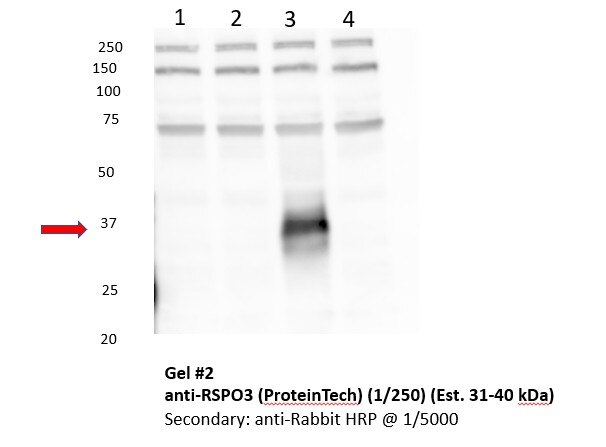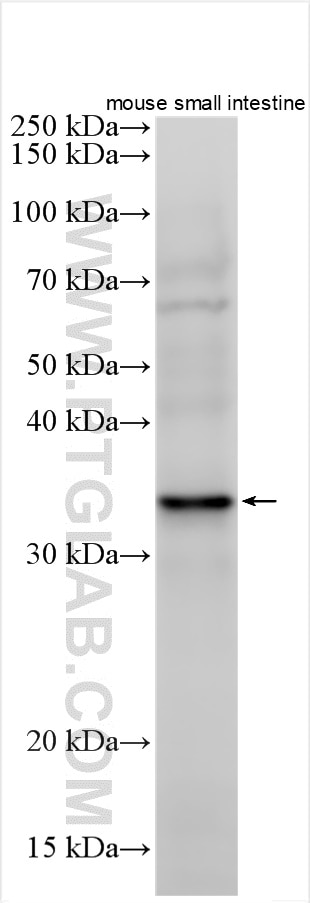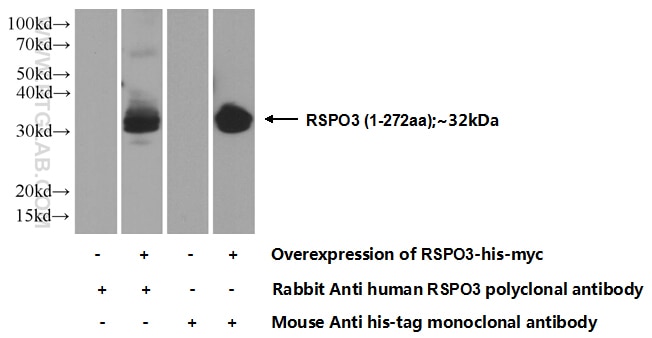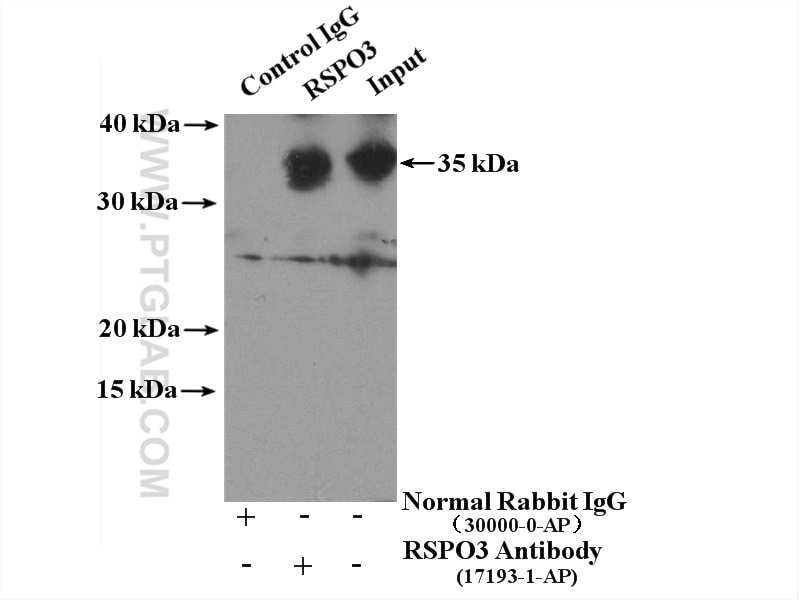- Phare
- Validé par KD/KO
Anticorps Polyclonal de lapin anti-RSPO3
RSPO3 Polyclonal Antibody for WB, IP, ELISA
Hôte / Isotype
Lapin / IgG
Réactivité testée
Humain, rat, souris
Applications
WB, IHC, IF, IP, ELISA
Conjugaison
Non conjugué
N° de cat : 17193-1-AP
Synonymes
Galerie de données de validation
Applications testées
| Résultats positifs en WB | tissu d'intestin grêle de souris, cellules HEK-293 transfectées |
| Résultats positifs en IP | tissu placentaire humain |
Dilution recommandée
| Application | Dilution |
|---|---|
| Western Blot (WB) | WB : 1:500-1:1000 |
| Immunoprécipitation (IP) | IP : 0.5-4.0 ug for 1.0-3.0 mg of total protein lysate |
| It is recommended that this reagent should be titrated in each testing system to obtain optimal results. | |
| Sample-dependent, check data in validation data gallery | |
Applications publiées
| KD/KO | See 2 publications below |
| WB | See 10 publications below |
| IHC | See 5 publications below |
| IF | See 4 publications below |
| IP | See 1 publications below |
Informations sur le produit
17193-1-AP cible RSPO3 dans les applications de WB, IHC, IF, IP, ELISA et montre une réactivité avec des échantillons Humain, rat, souris
| Réactivité | Humain, rat, souris |
| Réactivité citée | rat, Humain, souris |
| Hôte / Isotype | Lapin / IgG |
| Clonalité | Polyclonal |
| Type | Anticorps |
| Immunogène | RSPO3 Protéine recombinante Ag9899 |
| Nom complet | R-spondin 3 homolog (Xenopus laevis) |
| Masse moléculaire calculée | 272 aa, 31 kDa |
| Poids moléculaire observé | 30-40 kDa |
| Numéro d’acquisition GenBank | BC022367 |
| Symbole du gène | RSPO3 |
| Identification du gène (NCBI) | 84870 |
| Conjugaison | Non conjugué |
| Forme | Liquide |
| Méthode de purification | Purification par affinité contre l'antigène |
| Tampon de stockage | PBS with 0.02% sodium azide and 50% glycerol |
| Conditions de stockage | Stocker à -20°C. Stable pendant un an après l'expédition. L'aliquotage n'est pas nécessaire pour le stockage à -20oC Les 20ul contiennent 0,1% de BSA. |
Informations générales
RSPO3, also named as R-spondin-3, is a 272 amino acid protein, which contains 1 TSP type-1 domain and 2 FU (furin-like) repeats. RSPO3 may be a secreted protein and belongs to the R-spondin family. RSPO3 is expressed at higher level in placenta, small intestine, fetal thymus and lymph node. RSPO3 is an activator of the canonical Wnt signaling pathway by acting as a ligand for LGR4-6 receptors. The four R-spondins (RSPO1-4) and three related leucinerich repeat-containing G-protein coupled receptors, LGR4, LGR5, and LGR6 (LGR4-6), constitute a ligand-receptor system that plays critical roles in development, stem cell survival, and oncogenesis. Ectopic expression of RSPO2/3in mouse mammary epithelial cells led to an increase in invasiveness in vitro and in tumor formation and metastasis in vivo.
Protocole
| Product Specific Protocols | |
|---|---|
| WB protocol for RSPO3 antibody 17193-1-AP | Download protocol |
| IP protocol for RSPO3 antibody 17193-1-AP | Download protocol |
| Standard Protocols | |
|---|---|
| Click here to view our Standard Protocols |
Publications
| Species | Application | Title |
|---|---|---|
Nat Commun R-Spondin chromosome rearrangements drive Wnt-dependent tumour initiation and maintenance in the intestine. | ||
Cell Death Dis Endothelial cell-derived RSPO3 activates Gαi1/3-Erk signaling and protects neurons from ischemia/reperfusion injury
| ||
Heliyon Astragalus polysaccharide improves diabetic ulcers by promoting M2-polarization of macrophages to reduce excessive inflammation via the β-catenin/ NF-κB axis at the late phase of wound-healing |
Avis
The reviews below have been submitted by verified Proteintech customers who received an incentive for providing their feedback.
FH Gerald (Verified Customer) (07-23-2025) | Worked very well for Western Blot, showing a clear band at the expected molecular weight size, thereby confirming a successful transfection.
 |




